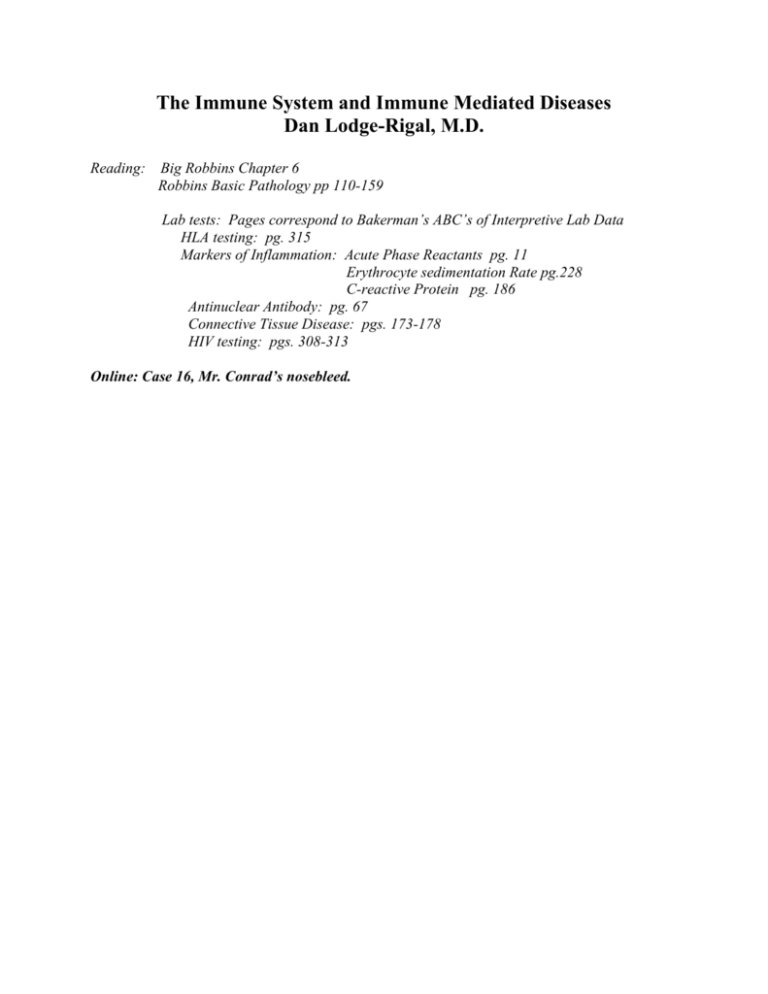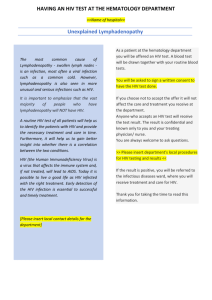Pathology and Pathogenesis of HIV Infection
advertisement

The Immune System and Immune Mediated Diseases Dan Lodge-Rigal, M.D. Reading: Big Robbins Chapter 6 Robbins Basic Pathology pp 110-159 Lab tests: Pages correspond to Bakerman’s ABC’s of Interpretive Lab Data HLA testing: pg. 315 Markers of Inflammation: Acute Phase Reactants pg. 11 Erythrocyte sedimentation Rate pg.228 C-reactive Protein pg. 186 Antinuclear Antibody: pg. 67 Connective Tissue Disease: pgs. 173-178 HIV testing: pgs. 308-313 Online: Case 16, Mr. Conrad’s nosebleed. Outline: 1. Review of Hypersensitivity Reactions 2. Systemic Autoimmune Diseases a. Tolerance and mechanisms of autoimmunity b. Autoantibodies c. Systemic Lupus Erythematosus d. Sjogren Syndrome e. Systemic Sclerosis f. Inflammatory myopathies g. Mixed connective tissue disease 3. Pathology of Transplantation a. Mechanisms of rejection b. Morphologic features of rejection c. Increasing graft survival d. Graft versus host disease e. Other complications. 4. Laboratory Assessment of Immune Status 5. Immunodeficiency: Congenital and Acquired a. Acquired versus congenital immunodeficiencies b. Clinical manifestations of congenital immunodeficiencies c. Selected Congenital Immunodeficiencies X-linked agammaglobulinemia (Bruton's) Common Variable Immunodeficiency IgA Deficiency Hyper IgM Syndrome Thymic hypoplasia (DiGeorge Syndrome) Severe Combined Immunodeficiency (SCID) Wiskott-Aldrich Syndrome d. Acquired Immunodeficiency Pathology and Pathogenesis of HIV Infection 6. Amyloidosis Reading: Robbins Basic Pathology pp 110-120 (review-hypersensitivity), 120-159 (new) Autoimmunity and Autoimmune Disease Tolerance and Mechanisms of Autoimmunity Mechanisms of Immunologic Tolerance Central: Peripheral: Mechanisms of Autoimmunity Barriers to intrathymic deletion Genetic factors and "suseceptibility genes" Infections and Autoimmunity Tissue injury (UV light) Other factors Autoantibodies Role in autoimmune disease: 1) 2) 3) 4) Antinuclear Antibodies Definition: Detection of ANA: Immunoassay (automated) versus indirect immunofluorescence. ANA: patterns of immunofluorescence: 1) 2) 3) 4) Systemic Autoimmune Diseases Tests for systemic inflammation: C-reactive protein Erythrocyte sedimentation rate (ESR or Sed rate) Systemic Lupus Erythematosus Defining: multisystem, variable signs/symptoms and clinical course Diagnostic criteria (Revised Criteria) Demographics Prevalence: Sex: Age: Race: Pathogenesis Genetic factors 1) 2) Environmental factors 1) 2) 3) 4) 5) Immune system abnormalities 1) 2) 3) Autoantibodies Antinuclear antibodies: Antiphospholipid antibodies: Other autoantibodies: Mechanism of tissue injury: 1) 2) 3) Pathology of Systemic Lupus Erythematosus Blood vessels: Kidneys: Glomerulonephritis: (Class I-VI) Skin: Joints: Central nervous system: Cardiovascular: Other: Lungs Liver Spleen Presentation and clinical course Treatment Mild- Moderate disease: Severe disease: Survival Variants of Lupus: Discoid lupus Drug Induced Sjogren Syndrome Definition: 1) 2) 3) Primary versus Secondary Clinical presentation Pathogenesis: Cellular and Humoral mechanisms Laboratory findings: ANA Rheumatoid factor (RF) Pathologic features: 1) 2) 3) Multisystem disease Extraglandular involvement occurs in ____ % Examples: 1) 2) 3) 4) Systemic Sclerosis (Scleroderma) Definition: Prevalence: Diffuse scleroderma: Localized scleroderma: C R E S T Etiology/Pathogenesis: Endothelial cell injury Immune activation Fibrogenic cytokines Autoantibodies: 1) 2) Pathologic features: Skin GI tract Kidney Lungs Heart Presentation and Clinical Course Raynaud phenomenon Skin changes Visceral involvement and associated symptoms Treatment: Prognosis/Survival: Other Autoimmune Disorders: Inflammatory Myopathies Dermatomyositis Polymyositis Associated autoantibody: Mixed Connective Tissue Disease Definition Associated autoantibody: Pathology of Transplantation Current Scope Mechanisms of Transplant (allograft) Rejection Antigen recognition: direct versus indirect Cell mediated rejection: Antibody mediated rejection: Morphology: Depends on time frame Hyperacute Acute Chronic Methods of Improving Graft Survival Compatibilitiy: ABO HLA antigens Immunosuppressive Therapy: 1) 2) 3) 4) 5) 6) NEJM Vol 351; 26 Dec 2004 Other factors to consider: Bone Marrow Transplantation (Hematopoietic Stem Cells) Graft versus Host Disease Pathogenesis Acute GVHD Chronic GVHD Treatment Other Complications of Transplantation Opportunistic infections Post Transplant Lymphoproliferative Disorders (PTLD) Laboratory Assessment of Immune Status Testing of Humoral Immunity: 1) 2) Testing of Lymphocyte Number and Function: 1) 2) 3) In Vivo Testing of Immune Function Testing of Innate Immunity Neutrophils: Number and Function NBT test: Complement: Total Components Immunodeficiency: Congenital and Acquired Acquired versus Congenital Immunodeficiencies 1) 2) Congenital Immunodeficiencies Clinical Manifestations of Congenital Immunodeficiencies Infections T cell defects: B cell defects: Granulocytes: Complement: Time frame: Other manifestations: 1) 2) Selected Congenital Immunodeficiencies: Disease with abnormal Immunoglobulin Production X-linked (Bruton's) Agammaglobulinemia Incidence: Clinical features: 1) 2) 3) Molecular defect: Other manifestations: Treatment: Common Variable Immunodeficiency (CVID) Incidence: Clinical features: 1) 2) Molecular defect: Other manifestations: Isolated IgA Deficiency Incidence: Clinical features: 1) 2) Molecular defect Other manifestations Hyper-IgM Syndrome Incidence: Clinical features: 1) 2) Molecular defect: Other manifestations: Diseases with predominantly T cell abnormalities Severe Combined Immunodeficiency (SCID) Incidence: Clinical features: 1) 2) 3) Inheritance Molecular defects: 1) 2) 3) Treatment (retroviral gene transfer, BM transplantation) Other Congenital Syndromes: DiGeorge Syndrome (22q11 deletion syndrome) C A T C H 22 Wiskott-Aldrich Syndrome: Triad: 1) 2) 3) Inheritance Molecular defect Other manifestations: Deficiencies of Innate Immunity Complement deficiencies 1) 2) 3) Neutrophil Deficiency Chronic Granulomatous Disease (CGD) Acquired Immunodeficiency: Pathology and Pathogenesis of HIV Infection Epidemiology Worldwide distribution of HIV Infection Risk Groups: Men who have Sex with Men (MSM) Intravenous Drug Users Heterosexual contacts of high risk groups Blood and Blood-product recipients Hemophiliacs Children born to HIV infected women (vertical transmission) Mode of Transmission Sexual Parenteral Mother-to-Infant Virology HIV 1 and HIV 2 Viral structure Viral Genome Viral Entry Pathogenesis of Infection T Cell Destruction Immunologic Consequences of T Cell Loss Macrophages and Dendritic Cells and HIV CNS Involvement by HIV Clinical and Immunologic features of Natural History of HIV Infection Clinicopathologic Features of AIDS "Acute HIV" Illness HIV associated Lymphadenopathy HIV and Lymphomas Kaposi's Sarcoma Cervical and Anal HPV-mediated Neoplasia Central Nervous system 1) 2) 3) 4) Infections Bacterial/Mycobacterial Community acquired bacterial infection Mycobacterium tuberculosis and Atypical mycobacteria Fungal and Protozoal Candida albicans Pneumocystis jeroveci Histoplasma capsulatum Cryptococcus neoformans Cryptosporidium Toxoplasma gondii Viral Cytomegalovirus Herpes simplex Epstein Barr Virus JC Virus Laboratory Testing in HIV Infection Diagnosis: Enzyme Linked Immunosorbant Assay (ELISA) Western Blot (confirmatory) P24 antigen testing PCR for HIV RNA/DNA Monitoring Disease Progression and Prognosis: HIV mRNA by PCR CD4 lymphocyte Quantitation Tailoring Drug Therapy/Detecting Resistance: HIV genotyping Amyloidosis Definition: Characteristics of Amyloid Pathogenesis: A disorder of abnormal protein Folding. AL amyloid AA amyloid Aβ amyloid Transthyretin β2 microglobulin Endocrine sources Pathology of Amyloidosis: Clinical Presentation and Diagnosis Treatment and Prognosis Immunopathology Study Questions Transplantation: 1. What is the difference between direct and indirect allograft recognition? 2. In acute rejection of the kidney, what pathologic change typifies cellular rejection? Antibody-mediated rejection? 3. What antigen system(s) are most important in graft rejection 4. How does HLA mismatch affect the probability of Graft vs Host disease (GVHD)? 5. What major organ systems are affected by GVHD? 6. Post transplant lymphoproliferative disorder is associated with what viral pathogen? Autoimmunity 1. What are the major clinical signs and symptoms of systemic lupus (SLE)? 2. What is a wire loop lesion? 3. What is the significance of a positive ANA in an asymptomatic individual? 4. What specific autoantibodies are helpful in the diagnosis of SLE? 5. How do discoid and drug-associated lupus differ from SLE? 6. Based on current knowledge, what main mechanisms are involved in immunologic tolerance? 7. Lupus is latin for ___________? 8. What is the antiphospholipid antibody syndrome? What is the relationship of APS to lupus? 9. Give an example of each of 3 different types of hypersensitivity reactions occurring in SLE. 10. Fibrous tissue deposition occurs most commonly in which organs in progressive systemic sclerosis (scleroderma, PSS)? 11. What is the pathogenesis of PSS? 12. What specific autoantibody(ies) is/are helpful in diagnosis of PSS? CREST? 13. What does CREST stand for? 14. True or False. Some patients can have spontaneous softening of their dermal sclerosis after years of disease. 15. What severe complication can be seen in PSS associated renal disease? 16. What is Raynaud’s phenomenon? 17. What is sicca syndrome? 18. Sjogren’s syndrome is most commonly associated with what other autoimmune disease? 19. What specific autoantibody(ies) is/are helpful in the diagnosis of Sjogren syndrome? 20. Anti-Jo and Anti-La are associated with what autoimmune disease (es) 21. How do dermatomyositis and polymyositis differ in terms of the target of the inflammatory process? 22. Patients with mixed connective tissue disease commonly have what autoantibody? 23. What is the genetic basis for Bruton’s agammaglobulinemia? 24. What infections are commonly associated with B cell deficiencies? T cell deficiencies? 25. Adenosine deaminase deficiency and Jak 3 mutations are associated with what congenital immunodeficiency? 26. What immunodeficiency is associated with anaphylactic reaction to transfusion of plasma-containing products? 27. The triad of eczema, thrombocytopenia, and recurrent infections is seen in what congenital immunodeficiency? 28. Which inherited immunodeficiency syndrome is associated with hypocalcemia? 29. What risk group has shown the greatest increase in proportion of new HIV infection over the last decade in the US? 30. What are major determinants of sexual transmission of HIV? 31. What are major determinants of perinatal transmission of HIV? 32. What is the significance of the LTR (long terminal repeat) region of the HIV genome? 33. How do CD 4 cells and macrophages bind HIV? How do they differ in terms of their interaction with the virus? 34. How is B cell function affected by HIV disease? 35. HIV is an a. RNA b. DNA virus? 36. How do CD4 count and Viral RNA quantitation (viral load) differ in terms of their clinical significance? 37. What are the “co-receptors” involved in HIV binding and entry? 38. Where does HIV virus reside during the clinical “latent” period? 39. How does HIV gain access to the central nervous system? 40. List several important mechanisms for T cell destruction in the course of HIV infection 41. How do the ELISA and Western Blot assays differ in terms of their role in diagnosis of HIV infection? What are causes of false positive ELISAs? 42. What is the pathogenesis of kaposi’s sarcoma? 43. What happens to the lymphoid tissues during the course of HIV/AIDS? 44. What malignancies are seen in higher frequencies in patients with HIV infection? 45. What is PML? 46. What are the most common clinical manifestations of the following opportunistic pathogens in the setting of HIV infection? a. Cryptococcus neoformans b. Pneumocystis carinii c. M. tuberculosis and M. avium complex d. Histoplasma capsulatum e. Toxoplasmosis f. JC virus 47. What type of amyloid protein is associated with each of the following? a. Plasma cell dyscrasia b. Systemic infection/inflammatory disorder c. Alzheimer’s disease d. Medullary thyroid carcinoma 48. What special stain is used to identify amyloid on tissue biopsies? 49. What tissues are most commonly affected in systemic amyloidosis?




